





Ketaminum
Application instruction:
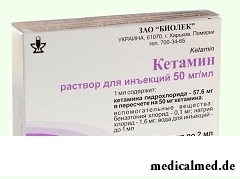 Ketamine – drug for not inhalation general anesthesia.
Ketamine – drug for not inhalation general anesthesia.
Form of release and structure
Dosage form – solution for intramuscular (in oil) and intravenous (in/in) introductions: the colourless or poorly painted transparent liquid (on 2 ml and 5 ml in ampoules or on 5 ml in bottles, on 5 pieces in a blister strip packaging, in a cardboard pack 1 or 2 packagings).
Active ingredient – Ketaminum a hydrochloride, in 1 ml of solution of 57,6 mg that is equivalent to 50 mg of Ketaminum.
Auxiliary components: sodium chloride, a benzetoniya chloride, water for injections.
Indications to use
- Basic and introduction general anesthesia (especially in need of preservation at patients of independent breath or at patients with low arterial pressure, and also at operations with artificial ventilation of the lungs by the respiratory mixes which are not including a dinitrogene oxide (nitrous oxide));
- Anesthesia at the emergency surgical interventions, including situations at evacuation of patients with blood loss and traumatic shock;
- As a part of multicomponent intravenous anesthesia at various surgical interventions;
- Anesthesia at catheterization of heart, endoscopy and other diagnostic procedures;
- Insignificant surgical manipulations when bandaging burn and other defeats.
Contraindications
- Myocardial infarction (including the period of the last 6 months);
- Arterial hypertension and other pathologies for which increase in arterial pressure is contraindicated;
- Stenocardia;
- Heavy renal failure;
- Disturbance of cerebral circulation (including in the anamnesis);
- The epilepsy and other diseases proceeding with convulsive activity;
- Alcoholism;
- Preeclampsia and eclampsia;
- Period of pregnancy and breastfeeding;
- Hypersensitivity to drug components.
With care apply a ketamine anesthesia at dekompensirovanny chronic heart failure, carrying out operation on a drink or a throat.
Route of administration and dosage
Ketaminum is applied in the way in/in fractional, single-step jet, drop or introductions in oil.
For adults the dose of drug is appointed from calculation: on 2-3 mg at in/in or on 4-8 mg on 1 kg of weight of the patient at introduction in oil.
The recommended dosing for maintenance of anesthesia at in introduction makes 0,5-1 mg or at in oil – on 3 mg on 1 kg of weight. Into drug it can be entered kapelno by means of an infuzomat with a speed of 2 mg at 1 kg of 1 hour or systems for infusions with introduction of 0,1% of solution of Ketaminum prepared from 5% by solution of a dextrose (glucose) or 0,9% chloride sodium solution, the speed of infusion of 20-50 drops in a minute.
At children introduction anesthesia at a balanced anesthesia is carried out after the corresponding premedication by single introduction of a dose in oil of drug at the rate of 4-5 mg on 1 kg of weight of the child in the form of 5% of solution.
At the main anesthesia Ketaminum enter solution, in oil in the form of 5%, or in/in in a dose from calculation for 2-3 mg on 1 kg of weight – in one step struyno (1% solution) or kapelno (0,1% solution) with a speed of 50-60 thaws a minute.
Dosing for introduction in oil depends on age and the child's weight:
- To babies till 1 year – from calculation for 8-12 mg on 1 kg;
- Children are 1-6 years old – on 6-10 mg on 1 kg;
- Teenagers are 7-14 years old – on 4-8 mg on 1 kg.
The general anesthesia is supported by repeated injections of drug in a dose: in oil – from calculation for 3-5 mg on 1 kg or in/in (struyno or kapelno) – on 0,5-1 mg on 1 kg, the speed of infusion is 0,1% of solution of drug of 30-60 drops a minute.
Effect of Ketamine is increased a combination to antipsychotic means (Droperidolum) and fentanyl, Promedolum and other analgetics, at this combination the dose of drug is recommended to be reduced.
Side effects
Use of Ketaminum can cause side effects:
- From cardiovascular system: tachycardia, increase in arterial pressure;
- From a nervous system: oppression of respiratory system, muscular rigidity, involuntary reduction of muscles; in the period of an exit from the general anesthesia – a hallucination, psychomotor excitement, psychosis, a long disorientation;
- From the alimentary system: nausea, hypersalivation;
- From respiratory system: an asthma, obturation of upper respiratory tracts because of sticking of language and a spasm of chewing muscles, a sialosis and high bronchial secretion;
- Local reactions: a pain syndrome in an injection site and a hyperemia on the vein course.
Special instructions
Use of Ketaminum is shown only in the conditions of ambulance or a hospital.
When using drug the patient can have a retraction of language or a spasm of chewing muscles therefore it is necessary to control breath function, especially passability of upper respiratory tracts.
When carrying out premedication it is recommended to include in composition of medicines: atropine or a metotsiniya iodide – for the prevention of increase in secretion of sialadens and mucous membranes; diazepam (in oil or in/in) – for prevention of uncontrollable twitchings and muscular rigidity; diazepam or Droperidolum – for the purpose of the prevention of development of psikhomimetichesky effects.
Slow introduction of the main dose of drug which should not exceed 3 mg on 1 kg of weight of the patient, and performing inhalation with air mix with oxygen in the ratio 2:1 is recommended.
When carrying out surgical interventions on a throat and a throat using Ketaminum, it is recommended to be careful and apply muscle relaxants.
Medicinal interaction
Drug strengthens action of narcotic analgetics, neuroleptics, drugs for the general anesthesia, anxiolytics (tranquilizers) and other means oppressing the central nervous system.
The combination to anxiolytics, antipsychotic means weakens a cardiopromoting effect of Ketaminum.
Use of Ketaminum is possible only in 1-2 days after cancellation of drugs of lithium, lincomycin, in 15 days after the termination of reception of inhibitors of a monoaminooxidase.
Solution of drug cannot be mixed with barbiturates in one syringe.
Ketaminum does not exert impact on effect of succinylcholine and a pankuroniya, strengthens myorelaxation action of Dithylinum and tubocurarine.
Simultaneous use of Droperidolum, Sibazonum and other benzodiazepines reduces risk of development of arterial hypertension, tachycardia, emergence of motor and psikhomimetichesky activity.
As simultaneous use of Ketaminum with the drugs possessing the stimulating impact on cardiovascular system and sympathomimetics leads to strengthening of aritmogenny and hypertensive action, increase in need of a myocardium for oxygen, it is recommended to avoid these combinations.
The patients accepting hormones of a thyroid gland and iodinated drugs in the period of the general anesthesia are subject to bigger risk of tachycardia and increase in arterial pressure.
Terms and storage conditions
To store in the place protected from light. To protect from children.
Period of validity – 2 years.
The weight of a human brain makes about 2% of all body weight, however it consumes about 20% of the oxygen coming to blood. This fact does a human brain extremely susceptible to the damages caused by shortage of oxygen.

Since the moment when the child becomes a school student, his sight begins to be exposed to the strengthened loadings which are supplemented viewing...
Section: Articles about health
Physical activity is necessary for normal functioning of a human body. At a lack of the movement joints cease to function, muscles atrophy, cardiovascular activity is broken and the metabolism worsens. Modern городс...
Section: Articles about health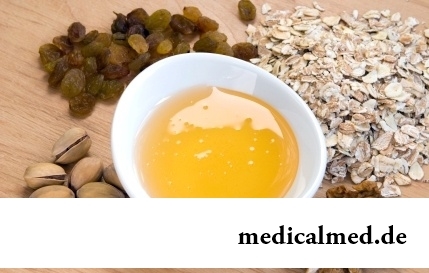
Let's begin with the fact that a separate illness which is called "adjournment of salts", just does not exist. In practice this household name of disbolism leading to development of a number of diseases. Pathological process consists that in an organism there is an accumulation of salts of uric acid (as a rule, owing to failure of a water salt metabolism or insufficiently effective work of secretory system)....
Section: Articles about health
Household skills which to us so diligently imparted in the childhood it appears, not always bring only benefit. According to result...
Section: Articles about health
Musicotherapy – a treatment method which caused and causes a set of a controversy concerning its efficiency. However the facts are relentless: during the numerous researches curative impact of music on an organism was scientifically confirmed. Since then in a number of the countries a method...
Section: Articles about health
The phenomenon of improvement of a condition of the patients at administration of drugs who are not containing active agents, so-called effect of placebo is known long ago. At the end of the 18th century the American doctor Perkins began to treat people the "miracle" sticks made of alloy of steel and brass. Was for several minutes to press such subject enough to a sore point that it became much easier for the patient. Having suspected Perkins of charlatanism, his colleagues tried to repeat "miracle" by means of sticks, steles...
Section: Articles about health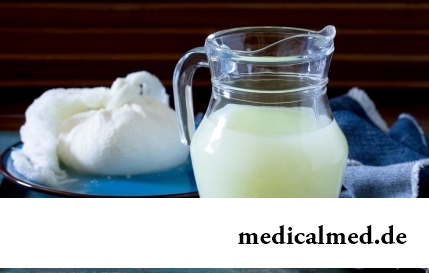
Milk and products of its processing by right occupy one of the main places in a diet of the modern person. They contain necessary...
Section: Articles about health
It is possible to find the extensive range of fruit and vegetables in modern shops. Russians already got used that on counters there is not only a seasonal domestic production, but the vegetables and fruit which are grown up in the countries with more comfortable conditions at all seasons of the year...
Section: Articles about health
A little more than a century ago goat milk was a traditional food stuff of most of Russians. Unfortunately, today on tables of our compatriots it appears extremely seldom. The reason that the use of so useful product practically came to naught, not only in very modest volumes of its production and, respectively, rather high cost. Potential consumers are just insufficiently informed on unique properties of goat milk and that advantage which...
Section: Articles about health
Water with a lemon - idle time in preparation drink which supporters of a healthy lifestyle already managed to appreciate. Upo...
Section: Articles about health
All got used long ago that, having addressed the plastic surgeon, it is possible to modify natural parameters of a figure or to minimize the damages put to appearance with ruthless time. Many people (preferential women) worldwide е...
Section: Articles about health
Sugar - the digestible refined product which is not of special value for an organism of the modern person. The use of sugar in food is based rather on the psychological dependence caused by desire to indulge itself with something tasty, and further and the biological, caused need of an organism for glucose as a result of big emissions of insulin in blood. Such circulation of insulin and glucose with continuous increase in portions of sugar is rather offensive and can become the reason for a narusha...
Section: Articles about health
High temperature - a frequent symptom of such widespread diseases as a SARS, quinsy, pneumonia, etc. To reduce heat, облег...
Section: Articles about health
Striya (extension) are the defects of skin having an appearance of direct or wavy strips from 1 to 10 cm long and 1-5 mm wide. In most cases at women of a striya are located on a stomach, hips, a breast or buttocks. At athletes they can appear on shoulders and внутренн...
Section: Articles about health
One of the useful properties presented to the person by the nature is ability to feel fear. This ability is designed to signal about approach of a dangerous situation and to help to avoid in advance it to keep life. However if the fear is persuasive and is not reasonable, it can seriously limit possibilities of the person in respect of socialization and self-realization. Such pathological fear is called a phobia....
Section: Articles about health
What will only not be thought up by persons interested to have a beautiful figure. Here the last innovation – for weight loss needs to be eaten greasy food. Give ра...
Section: Slideshow
According to World Health Organization, every third inhabitant of Earth has excess weight, and every tenth has obesity. The reason of this phenomenon, according to specialists, roots in one not very comforting fact: most of people consume much...
Section: Articles about health
Eyes – unique body on the structure thanks to which the person obtains about 80% of information on the world around: about a form, color, size, the movement, and also many other parameters of objects or phenomena. But whether much we know about the most valuable sense body which, according to the scientist Sechenov, provides us about one thousand various feelings a minute? Let's consider 10 most surprising facts about eyes and sight....
Section: Articles about health
Ability of an organism to resist to adverse environmental factors (to impact of temperature drops, humidity and pressure...
Section: Articles about health
Summer in the heat. Many are going to spend vacation abroad. Travelers the tender seas, rest on beaches wait, for sightseeing, campaigns on natural and cultural reserves. But, unfortunately, on vacation also problems about health can wait for us...
Section: Articles about health
So, you resolved to lose weight. And now you try to understand what to begin with: from exercise stresses or a diet? And how to make that process of weight loss did not give you an inconvenience, and, on the contrary, brought joy?...
Section: Slideshow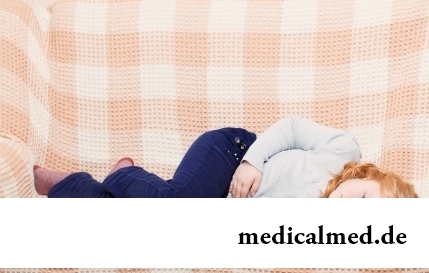
Epilepsy is one of widespread neurologic diseases. To parents, whose children suffer from this illness, it is necessary...
Section: Articles about health
For anybody not a secret that our country is one of the most "drinking" in the world. At clear understanding that the use of hard alcoholic drinks – occupation extremely harmful, most of Russians belong to alcoholism with unjustified loyalty. These...
Section: Articles about health
Cellulitis - very widespread cosmetic shortcoming which arises approximately at 80% of women sooner or later. Emergence it is connected with change of structure of a hypodermic fatty layer. At the same time on the surface of skin at first there are roughnesses (cambers and cavities), and then small consolidations, the so-called effect of an orange-peel is shown. Changes in a condition of hypodermic cellulose are a consequence of a hormonal imbalance in an organism....
Section: Articles about health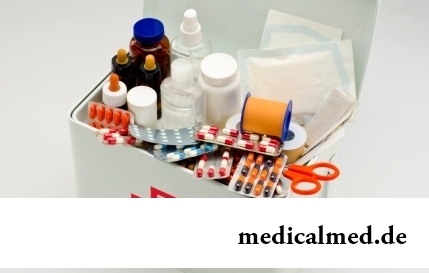
All know that self-treatment is dangerous. However absolutely it is almost impossible to do without it. Rate of modern life not on...
Section: Articles about health
No, probably, the person who would not have cold. Cold, cough, a headache – these symptoms are known to everyone. The peak of catarrhal diseases is the share of fall. SARS already came to schools and kindergartens, flu slowly makes the way to the cities, in a word, з...
Section: Articles about health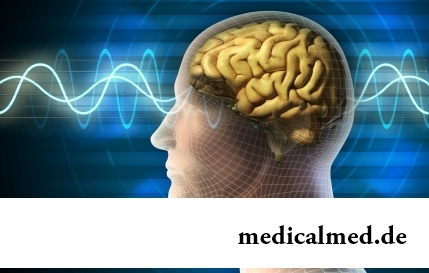
The brain of the person is studied not one hundred years, but the quantity of the riddles connected with this body increases rather, than decreases. Perhaps, numerous delusions concerning a structure and functioning of a brain are explained by it, many of which arose long ago, but continue to exist and today. Such we are ready to acquaint readers with the most widespread myths....
Section: Articles about health
